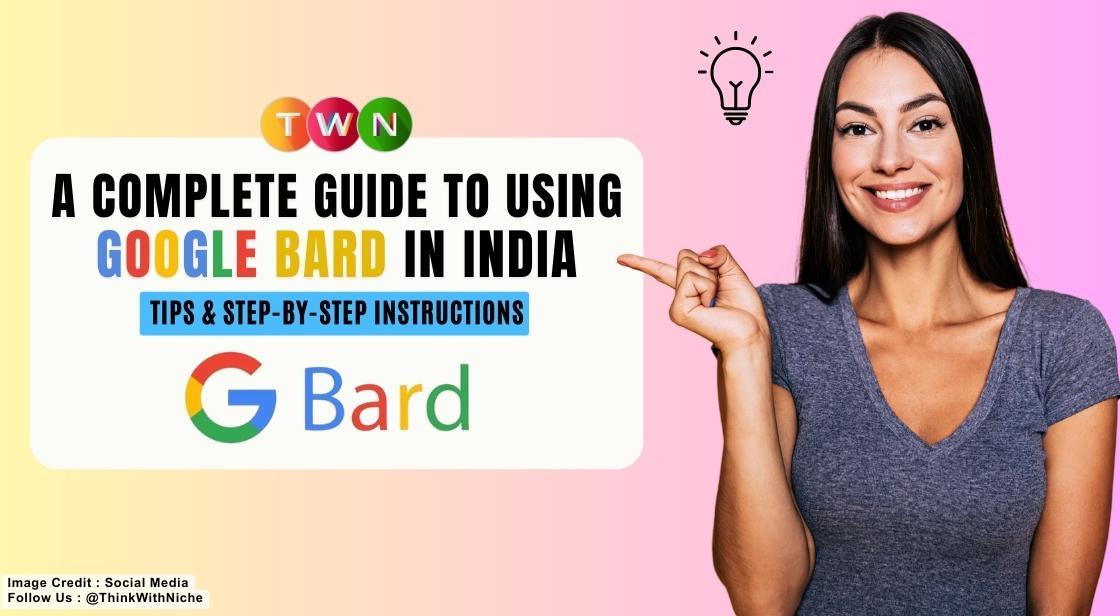A Complete Guide to Using Google Bard in India: Tips and Step-by-Step Instructions

Blog Post
Google Bard is a large language model from Google AI, trained on a massive dataset of text and code. It can generate text, translate languages, write different kinds of creative content, and answer your questions in an informative way. It is still under development, but it has learned to perform many kinds of tasks.
Google Bard is a revolutionary AI-powered tool that can help users generate creative and coherent text content. With its ability to understand the context and generate text based on user input, Google Bard has become a popular tool for content creators and marketers. In India, the tool has gained popularity among bloggers, writers, and social media influencers who use it to create engaging and informative content for their audience.
This complete guide to using Google Bard in India provides step-by-step instructions and useful tips for maximizing the tool's potential. By following these instructions and tips, users can create compelling and unique content that resonates with their target audience. Whether you are a beginner or an experienced user, this guide is a valuable resource for anyone looking to harness the power of Google Bard for their content creation needs.
Google Bard is a large language model (LLM) chatbot developed by Google AI. It is a machine learning model trained to generate text, translate languages, write different kinds of creative content, and answer your questions in an informative way. Bard is still under development, but it has learned to perform many kinds of tasks
Creation of Google Bard and Its History of Development
Google Bard was created by a team of engineers and scientists at Google AI. The team was led by Blaise Agüera y Arcas, the head of Google AI. The team started working on Google Bard in 2017. They used a massive dataset of text and code to train Google Bard. The dataset included books, articles, code, and other forms of text.
Google Bard was first announced in 2022. It was released to the public in 2023. Google Bard is still under development, but it has learned to perform many kinds of tasks. It is a powerful tool that can be used for a variety of purposes.
To achieve this, the team at Google used a state-of-the-art neural architecture called the Transformer, which was first introduced by Google in 2017. The Transformer model is known for its ability to understand the context of text and generate high-quality text output. The Google team made several modifications to this architecture to develop the final version of Google Bard.
The development process for Google Bard was an extensive one and involved training the model on a massive amount of data. The team at Google used a technique called unsupervised learning to train the model, which allowed it to learn from large amounts of text without the need for explicit labeling of the data. The data used for training included a diverse range of texts, including poems, songs, and stories.
Once the model was trained, it was tested on several datasets to evaluate its performance. The results were impressive, with Google Bard generating poetry, songs, and stories that were comparable in quality to those created by humans.
Google Bard's development is part of a larger trend in the AI world of creating language models that can generate creative content. This has applications not just in the arts but also in industries such as advertising and marketing, where generating compelling and contextually relevant content is key to success.
The development of Google Bard is a testament to the potential of AI language models to generate creative and meaningful content. It represents a significant step forward in the field of natural language processing and has the potential to revolutionize how we interact with language in the digital age.
What is Google Bard and How Does it Work?
Google has launched its own AI language model called Bard in India to compete with other language models like ChatGPT. Bard can generate creative pieces of poetry and song lyrics, making it an excellent tool for writers, musicians, and anyone who wants to express their creativity through words.
To use Google Bard, simply go to the Bard website (https://bard.withgoogle.com/).and log in with your Google account. Choose a theme that resonates with you the most, such as nature, love, or food. Enter a prompt or question that gives Bard an idea of what you want to write about. Be specific and provide as much detail as possible to get the best results. Google Bard will generate a response based on your prompt.
You can refine the generated content by editing and adding your own personal touch. You can also view other drafts for each response and give feedback by thumbs up or down. Once you're happy with your piece, save it to your Google account and share it with your friends or on social media.
Google Bard is a large language model from Google AI, trained on a massive dataset of text and code. It can generate text, translate languages, write different kinds of creative content, and answer your questions in an informative way. It is still under development, but it has learned to perform many kinds of tasks.
A Complete Guide to Using Google Bard in India: Tips and Step-by-Step Instructions
How to Use Google Bard for Creative Writing
Here are some tips on how to use Google Bard for creative writing:
-
Start with a clear idea of what you want to write. What is the genre of your writing? What is the tone you want to set? What is the message you want to convey?
-
Give Google Bard as much information as possible. The more information you give, the better Google Bard will be able to generate text that meets your needs.
-
Be specific in your instructions. The more specific you are, the more likely Google Bard is to generate text that meets your expectations.
-
Be patient. Google Bard is still under development, so it may not always generate text that is perfect. However, with patience and practice, you can learn to use Google Bard to generate high-quality creative content.
Here are some examples of how Google Bard can be used for creative writing:
-
Poetry: Google Bard can be used to generate rhyming and structured poetry. This can be a great way to save time for poets and provide a source of inspiration for their work.
-
Fiction: Google Bard can be used to generate stories, novels, and screenplays. This can be a great way to get started on a new project or to help you brainstorm ideas.
-
Non-fiction: Google Bard can be used to generate articles, essays, and reports. This can be a great way to research a topic or to get started on a new project.
-
Emails: Google Bard can be used to generate emails, letters, and other forms of correspondence. This can be a great way to save time and to ensure that your communication is clear and concise.
-
Social media posts: Google Bard can be used to generate social media posts, blog posts, and other forms of online content. This can be a great way to connect with your audience and to share your thoughts and ideas.
Google Bard is a powerful tool that can be used for a variety of creative writing tasks. With a little practice, you can learn to use Google Bard to generate high-quality content that meets your needs.
Step-by-Step Instructions to use Google Bard
Google Bard is a new tool that helps people generate creative writing using artificial intelligence. If you're interested in using this tool for your own creative writing projects, here's how to get started:
Accessing Google Bard
1. Access Google Bard by logging in to the Bard site with your Google account.
Choosing Themes and Submitting Prompts
2. Choose one of the available themes, such as nature, love, or food.
3. Enter your prompt or question in the text box at the bottom of the page.
4. Submit your prompt by clicking the "Submit" button.
5. Customize your prompt by being specific and providing as much detail as possible.
Generating and Refining Content
6. Google Bard will generate a response based on your prompt and theme.
7. Keep clicking the "Generate" button to generate more content, and use the "View other drafts" button to see additional variations.
8. Edit and refine the content to make it more specific or add your own personal touch.
9. Use the thumbs up or down button to provide feedback on the generated content.
Saving and Sharing Your Work
10. Save your piece to your Google account when you're happy with it.
11. Share your work with friends or on social media.
12. Come back to your work later to make further changes or improvements.
By following these steps, you can use Google Bard to generate creative writing and improve your writing skills. With its easy-to-use interface and customizable prompts, Google Bard is a valuable tool for anyone interested in creative writing.
Also Read: Unlocking The Benefits Of Artificial Intelligence For Your Business
Tips for Using Google Bard
-
Be specific and detailed when asking your questions or prompts
-
Use natural language to help Bard understand your request
-
Be patient, as Google Bard is still under development and may not always provide perfect answers.
Google Bard vs. ChatGPT:
Use the Internet to Search
Bard uses the internet to search for answers to questions, while ChatGPT currently does not allow users to access the internet. This gives Bard the ability to provide more information and answer questions with greater accuracy.
Integration with Gmail
Google revealed that Bard will be integrated with Gmail, allowing users to write emails for different occasions right in the app. This integration is not yet available on ChatGPT.
Easily Export to Google Docs and Gmail
Bard allows users to export content generated by it to Gmail and Google Docs, making it easier to use the content it generates. In contrast, while using ChatGPT, users can only copy the content.
Voice Prompts
Users can use voice prompts to ask questions to Bard, which is currently not possible with ChatGPT. This feature is convenient, especially when multitasking, as users can ask questions without typing.
Provide the Latest Information
As Bard is connected to the internet, it can provide users with up-to-date information. ChatGPT, on the other hand, is limited to events up to September 2021. This makes Bard a better tool for both professionals and students as they can get the latest information.
Summarize Webpages
Bard offers the ability to summarize web pages due to its internet connectivity. Users can quickly summarize webpages by sharing the link. In contrast, ChatGPT cannot connect to the internet, and users have to copy-paste the content they want to summarize.
Coding
Google’s Bard supports over 20 programming languages and can explain programs just by using a link to it. While ChatGPT is also proficient at coding, it cannot explain programs if users provide a link to it.
Find Search Results Related to Your Prompt
In addition to answering users' questions, Bard provides them with searches related to their prompt. This feature makes it easier for users to continue their search and gives them an idea about what to look for. This is another area where ChatGPT is currently behind.
ThinkWithNiche Conclusion
Google Bard is an AI chatbot and language model developed by Google that uses natural language processing and machine learning to generate creative content such as poetry and song lyrics. With its launch in India, it has become a competitor to the Microsoft-supported ChatGPT. This article provides a step-by-step guide on how to use Google Bard, including tips for generating high-quality content. While Google Bard is still under development, it has the potential to be a valuable tool for writers, musicians, and anyone looking to express their creativity through words.
Google's Bard offers some significant advantages over ChatGPT. Its integration with Gmail, voice prompts, ability to provide the latest information, and support for over 20 programming languages make it a more versatile tool. Summarizing web pages and finding search results related to the prompt are additional benefits that make Bard a more comprehensive chatbot.
You May Like
EDITOR’S CHOICE












